You Got Your Tentacles in my Comic Book: Cthulhu Tales
By
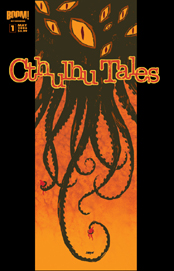 Most of the classic pulp writers who are popular, are not just great story tellers but great craftsmen as well. They don’t just paint vivid word pictures but write with such competency and skill that the stories and characters are easily transferable to other mediums. Edgar Rice Burroughs, Raymond Chandler, Zane Gray, and Robert E. Howard spring instantly to mind. H. P. Lovecraft does not.
Most of the classic pulp writers who are popular, are not just great story tellers but great craftsmen as well. They don’t just paint vivid word pictures but write with such competency and skill that the stories and characters are easily transferable to other mediums. Edgar Rice Burroughs, Raymond Chandler, Zane Gray, and Robert E. Howard spring instantly to mind. H. P. Lovecraft does not.
No one ever created a sense of horror better nor created a more original set of origins of this horror; the Old Ones. But he was not a good writer. Every story is composed of dense, turgid prose that the reader often has to fight his way through. The stories have little action but rely upon a slowly building realization that something is deeply wrong; an unfolding of foreboding into an agony of horror that the author often describes as indescribable. While the effectiveness of Lovecraft’s ideas cannot be denied, the ability to transfer them to other media seems almost insurmountable. The greatest success is found in pastiches wherein another genre is overlaid, as in the film Cast A Deadly Spell which uses the private eye/film noire format as added interest, or in Shadow Over Baker Street, an anthology of short stories that rely on Sherlock Holmes to carry the actual interest.
In this book there are six short stories that use the Cthulhu mythos as a starting point, and while they strive manfully to turn Lovecraft’s nightmares into something that is as disturbing and repulsive as the original, the effort remains unsatisfying. Where Lovecraft can use the imagination of the reader to supply an amorphous, and thereby individually unsettling image, here the artist is compelled by the medium to supply something concrete, which immediately undermines the effort. Boom Studios tries to bring us unusual new reading experiences with each new title. This is a valiant effort that has some real qualities to recommend it, both in writing and artwork. They should not feel any onus from not being able to surmount what the seminal work saddled them with.
RATING: 
Drew Melbourne Had A Worse Roommate Experience Than You Did in Archenemies
By Jeb D
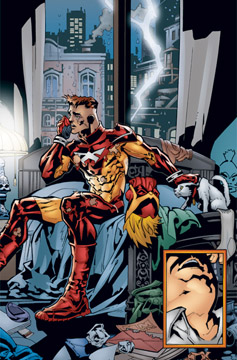 Archenemies is what they call “high concept”—that is, the hook of the series can be explained in one quick catch phrase. In this case it’s “The Odd Couple with superpowers.”
Archenemies is what they call “high concept”—that is, the hook of the series can be explained in one quick catch phrase. In this case it’s “The Odd Couple with superpowers.”
Of course, there’s more to a series than a “hook”, and in Archenemies, writer Drew Melbourne mines the concept for something richer than obvious mismatched-roommate jokes. He’s having fun playing with superhero stereotypes of all kinds (a nice touch is that heroic Ethan “Star Fighter” Baxter is the slob, while villainous Vince “Underlord” Darko is the fastidious neatnik). While the underlying premise is that these two incompatible roommates are stuck with each other (neither wants to leave the rent-controlled space to take their chances on a pricey rental market), they still don’t realize who the other is. Getting saddled with a bad roommate can make you feel as though you’re living with your “archenemy”: here, it’s happening literally.
Issue #1 introduced the pair, while quickly and cleanly laying out the environment they’ll be operating in.
The art team (Yvel Guichet on pencils, the legendary Joe Rubinstein inking) gives the book a big and bold look that suggests a slightly darker, more detailed, version of Stuart Immonen’s Nextwave or Cory Walker’s Invincible.
The backup features are fun, too: an interview with Star Fighter’s diminutive mentor,
Whether Melbourne can make this premise work over an extended period of time is hard to say (the idea of the roommates continuing to keep their secrets from each other would likely feel strained after a few more issues), but fans of titles like Noble Causes or Invincible should really take a look at Archenemies.
RATING: 
My Inner Bimbo: insightful but tedious reading
By Graig
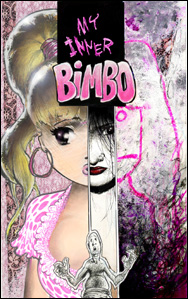 I’ve been a Sam Kieth fan for quite some time now, sourcing back to when he was running with Marvel Comics Presents and Dark Horse’s Aliens (though he had almost a decade of work before that, Sandman included) and my original interest was in his illustration. His style is uniquely his own (all those curls of shredded fabric), few have attempted and none have succeeded in copying or mimicking it, in part because he’s constantly evolving and manipulating his technique between hyper-detailed and simplified cartoons (as a result, no doubt, of his collaboration with artist Josh Hagler). So strong is his aesthetic that I don’t ever need to see his name to know when a piece is his (Oni must feel the same way since his name doesn’t appear on the cover of My Inner Bimbo #1), his paintings always working in a common palette. When he brought forth the Maxx amidst a spate of other Image Comics launches in the mid-90’s, most of which were style-over-substance superhero books, no one predicted how rich a story, how conceptually abstract and challenging the Maxx would become. Through the Maxx, and with help from William Messner-Loebs, Kieth honed his skills as a writer, and found an unusual voice in his capability of writing women that were anything but clichéd or cookie-cutter. Though off-setting his off-beat endeavours with more commercial efforts like Wolverine/Hulk or the recent Batman: Secrets, he’s consistently come up with something different like Zero Girl, Four Women, and Ojo.
I’ve been a Sam Kieth fan for quite some time now, sourcing back to when he was running with Marvel Comics Presents and Dark Horse’s Aliens (though he had almost a decade of work before that, Sandman included) and my original interest was in his illustration. His style is uniquely his own (all those curls of shredded fabric), few have attempted and none have succeeded in copying or mimicking it, in part because he’s constantly evolving and manipulating his technique between hyper-detailed and simplified cartoons (as a result, no doubt, of his collaboration with artist Josh Hagler). So strong is his aesthetic that I don’t ever need to see his name to know when a piece is his (Oni must feel the same way since his name doesn’t appear on the cover of My Inner Bimbo #1), his paintings always working in a common palette. When he brought forth the Maxx amidst a spate of other Image Comics launches in the mid-90’s, most of which were style-over-substance superhero books, no one predicted how rich a story, how conceptually abstract and challenging the Maxx would become. Through the Maxx, and with help from William Messner-Loebs, Kieth honed his skills as a writer, and found an unusual voice in his capability of writing women that were anything but clichéd or cookie-cutter. Though off-setting his off-beat endeavours with more commercial efforts like Wolverine/Hulk or the recent Batman: Secrets, he’s consistently come up with something different like Zero Girl, Four Women, and Ojo.
Kieth’s strength as a writer isn’t necessarily in his storytelling, but rather a constructor of characters. Kieth gets nuance, and even more, he understands quirk. He has the innate ability to inject psychological, metaphysical, environmental, physiological and other sorts of quirk into his characters that on the one hand ground them, and on the other give them something interesting to tune into, a reason for reading.
With My Inner Bimbo, Kieth looks at the repressed sexuality of a sixty-year-old man named Lo (the grandfather from Ojo). Lo is married to a woman a dozen years his senior, and he has a complicated relationship with her, since, he acknowledges, she’s a great deal smarter than he is, and generally he’s a wuss. One night Lo’s sexual desires manifest themselves into the form of Bambi, a barely legal blonde ditz. Bambi seemingly grants Lo his every desire, but as a facet of his subconscious, she winds up bringing thoughts, visions, and fantasies to the fore that Lo feels guilty or uncomfortable with. Bambi emerges to apparently help Lo grow out of his youthful, but appearances can be deceiving.
Through an intense and dense narrative alternating between Lo’s voice and Bambi’s (both acting, ostensibly, as the author’s), issue one of My Inner Bimbo delivers a thorough examination of patterns in Lo’s life, as well as a rich diary-like history of his relationship with his wife and her past. This seems very introspective at times, and doubtlessly holds some personal relevance for Kieth. If anything though, this first issue is too dense, too rich in information, to the point where it’s too much to process in one sitting (this is the first 32 page floppy that has ever taken me three sittings to read through). I felt the book was rather aimless at first, but as more and more of Lo’s past and patterns are revealed, there’s interesting, somewhat Cronenbergian philosophical and psychological contexts involved. At the same time, it’s exhausting reading, which I imagine may prove challenging to follow on an issue-by-issue basis over five books.
RATING: 
“It’s the End of the Marvel Universe As We Know It”– And We’re Only Two Issues Into Civil War!
By Jeb D.
 Remember Y2K? December 31st, 1999. We all sat in front of the TV waiting to see what the stroke of midnight would bring: Digital clocks no longer working? Planes falling from the sky? Computers revolting and taking over the world? Well, sure, few of us thought that the more extreme predictions would come true. But as we sat there, watching the new day strike all over the globe, there was the sense that we were quite possibly waiting for the seconds to tick down to an entirely new world.
Remember Y2K? December 31st, 1999. We all sat in front of the TV waiting to see what the stroke of midnight would bring: Digital clocks no longer working? Planes falling from the sky? Computers revolting and taking over the world? Well, sure, few of us thought that the more extreme predictions would come true. But as we sat there, watching the new day strike all over the globe, there was the sense that we were quite possibly waiting for the seconds to tick down to an entirely new world.
And that’s what’s happening in issue #2 of Mark Millar’s enjoyable Civil War series. It’s the evening before the Superhero Registration Act becomes law, and we’re shown the range of reactions throughout the superhero community. During the countdown, tensions run high among familiar characters, and we can see some unexpected fault lines beginning to show (the Fantastic Four, in particular, are clearly a focal point of conflict). Finally, the clock strikes midnight, and all hell breaks loose. Captain America’s “underground” moves from being an embarrassment to the government to a full-fledged resistance force, artist Steve McNiven delivers an action sequence that wouldn’t feel out of place on “24”, and the issue wraps up with a stunning new revelation. And while I realize that this revelation been spoilered all over the Internet, for those who might be trying to tradewait, I’ll keep it under my hat.
I will say this, though: as a plot point, I’m not particularly happy about it, but I love the fact that it underscores what Millar’s been promising all along: this series will reshape the Marvel Universe into something new and different. Sure, there’s no guarantee that I’ll like that “new” version of it (or that it won’t be changed back one day), but I’m definitely intrigued to see what comes next.
RATING: 
A Once-Supreme Series Becomes Less So With Each Issue: Squadron Supreme #4
By Jeb D.
 I was all for J. Michael Straczynski moving his Supreme Power title from Marvel’s MAX line to the Marvel Knights imprint, thus shedding the “adults only” stigma. The dark superhero tale was never about cussing and boobies (though it had its share), and its interesting inversion of The Authority and JMS’ own Rising Stars was often as much a moody horror story as a super-powered extravaganza; it seemed a good notion to let under-18 readers have a chance to enjoy it.
I was all for J. Michael Straczynski moving his Supreme Power title from Marvel’s MAX line to the Marvel Knights imprint, thus shedding the “adults only” stigma. The dark superhero tale was never about cussing and boobies (though it had its share), and its interesting inversion of The Authority and JMS’ own Rising Stars was often as much a moody horror story as a super-powered extravaganza; it seemed a good notion to let under-18 readers have a chance to enjoy it.
Since it re-started as Squadron Supreme, though, it’s been disappointingly conventional. Instead of the slow, detailed building of the original team, inside of four issues we’ve now got a small army of superbeings, with new ones popping up in other countries, and the chilling isolation of the original series is giving way to a feeling of being cramped and overpopulated. It’s not helping that the stories so far have been kind of by-the-numbers “Authority-lite” stuff.
This month, things look as though they might pick up when lethal genius Emil Burbank (arguably the best character in the series) uses the team’s assignment in the Middle East to start practicing a deadly “hobby”, but at that point, the story switches (and grinds) gears, jumping to the background of the character called Inertia. Her childhood, wouldn’t you know, was a troubled one, and to absolutely no one’s surprise her Bible-thumping father turns out to be a moral hypocrite who sets the girl on her life’s tragic path. It’s a tedious cliché, and completely derails the story.
Gary Frank continues his fine work on the art chores, but Straczynski needs to get this book back under control, fast, or the upcoming crossover into the Ultimate Universe will finally turn this once-great series into just another mildly interesting variation on the JLA.
RATING: 
Marvel Goes Way Out West—Or Maybe Just Way Out—With “Two-Gun Kid”
By Jeb D.
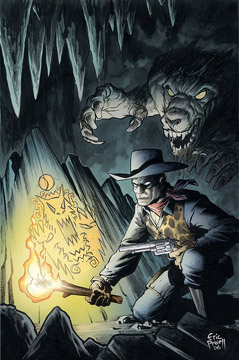 Another somewhat baffling offering from the Marvel marketing department. I’d love to know which focus group suggested that the comic marketplace was looking for a new series of Western books (the same one that said they’d buy Sable & Fortune?). But, regardless of the likely sales indifference it faces, the first of the series of Western one-shots arrives this week with Two-Gun Kid #3 from Dan Slott and Eduardo Barreto.
Another somewhat baffling offering from the Marvel marketing department. I’d love to know which focus group suggested that the comic marketplace was looking for a new series of Western books (the same one that said they’d buy Sable & Fortune?). But, regardless of the likely sales indifference it faces, the first of the series of Western one-shots arrives this week with Two-Gun Kid #3 from Dan Slott and Eduardo Barreto.
While I doubt this will do much to help Slott’s sales profile, it’s a book that should appeal to fans of his She-Hulk series. In fact, I’d go so far as to say that it’s more or less essential reading for She-Hulk fans (though it does contain one significant, if not unexpected, spoiler).
Slott opens the main story with She-Hulk and the “ripped-from-his-own-time” Matt (Two-Gun Kid) Hawk on a contemporary adventure that inevitably takes us back to one of the Kid’s Old West outings. Slott’s story of saddles, sidearms, and the supernatural has a nice vintage feel to it, honoring the conventions of the genre while getting in a few good laughs (boy, there sure were a lot of masked riders back in the day, eh?) and some nice chills. Barreto handles the six-shooter mayhem beautifully, but when the story comes full circle to the present day, Slott sucker-punches us with a seemingly tragic ending “continued in She-Hulk #11”. Which is just fine for all right-thinking people reading She-Hulk, but I suspect will piss off those folks who might have picked this up just because they really DID want to read a good old-fashioned Western. Caveat emptor, pardner.
The second story, “Tall Tale”, is a somewhat amusing, if a bit outré, 6-page outing from Keith Giffen, Robert Loren Fleming, and Mike Allred. Be aware that Native Americans, for once, are not the minority that may be less than amused. The book concludes with a reprint of a ripping, eye-poppingly gorgeous Stan Lee-Jack Kirby “Rawhide Kid” tale.
Verdict? You got me. The main story’s a lot of fun, but She-Hulk fans may be unhappy at spending having to spend $3.99 so as not to miss a key development in her own book. Western fans may feel like they’re being strongarmed into trying a She-Hulk series that, while admittedly excellent, isn’t necessarily going to be their cup of tea. And those of small stature may have a few choice words for Messers Giffen and Fleming.
RATING: 
Ursa Minors! – guys in bear suits attempt to get a laugh
By Graig Kent
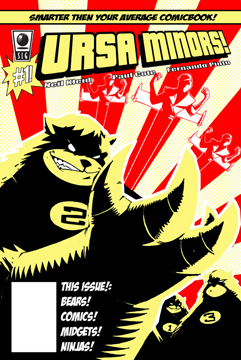 Can I talk about the “M” word for a second? It’s emblazoned on the cover of Ursa Minors! #1, used in the context that it’s traditionally used, as an accentuation point for comedy. But, if you didn’t know, “midget” is an offensive term to the Little Person community, they liken it to calling a black person “nigger”. The term stems from the PT Barnum’s carnival days where having a height deficiency was seen as a freakish, and even more it was a divisive term used to distinguish the more “socially acceptable” dwarfs from the rest. It’s a term that, because of its origin has offensive undercurrents, and there’s a whole aspect of our civilized society that doesn’t take kindly to it. Before you jump on me about being a left-wingy liberal hippy, this is not about being politically correct; it’s about decency and respect. So just as you wouldn’t use Nip, Wop, Nigger or countless other slurs as an accentuation point on the cover of a book or as the punch line of a joke (subject to your own prejudices and taste levels, of course), try to retire “Midget” from your vernacular, or at least have a better understanding of what the word actually means, and understand the bite that the word actually has. (*More on the “m” word: http://www.arturogil.com/m_word.htm)
Can I talk about the “M” word for a second? It’s emblazoned on the cover of Ursa Minors! #1, used in the context that it’s traditionally used, as an accentuation point for comedy. But, if you didn’t know, “midget” is an offensive term to the Little Person community, they liken it to calling a black person “nigger”. The term stems from the PT Barnum’s carnival days where having a height deficiency was seen as a freakish, and even more it was a divisive term used to distinguish the more “socially acceptable” dwarfs from the rest. It’s a term that, because of its origin has offensive undercurrents, and there’s a whole aspect of our civilized society that doesn’t take kindly to it. Before you jump on me about being a left-wingy liberal hippy, this is not about being politically correct; it’s about decency and respect. So just as you wouldn’t use Nip, Wop, Nigger or countless other slurs as an accentuation point on the cover of a book or as the punch line of a joke (subject to your own prejudices and taste levels, of course), try to retire “Midget” from your vernacular, or at least have a better understanding of what the word actually means, and understand the bite that the word actually has. (*More on the “m” word: http://www.arturogil.com/m_word.htm)
Rant and distasteful cover copy aside; let’s talk about Ursa Minors! #1, the new series from Slave Labor Graphics. Set in a near future society where high-tech animal suits are the fashion of the day, the Ursa Minors are a trio of 1980’s pop-culture obsessed punk-geeks who live a relatively slack lifestyle operating a comic book/ice cream shop. When one of the boys arranges a date on-line, the other boys tag along just to make sure the “usual” trouble doesn’t happen… which, of course, it does, seeing as the “girl” actually turns out to be their arch-nemesis, Lord Shattercock. The inevitable brawl involving the beating of ninjas and the destruction of property closes out the story, inexplicably capped with a punch line referencing the Ice Pirates.
The book rounds out with the brief and corny Rabbi Ninja, plus a spin on the old Hostess Fruit Pie adverts with Kevin Smith robots running rampant, and the Minors having to stop them with the aide of … BEER!
The story and dialogue by Neil Kleid are mildly amusing, but the jokes are often stale or just not that funny, and the pop-culture references are hitting the 30 to 40 age bracket, limiting the number of people who are going to find the allusions entertaining. Fernando Pinto has a sure line, with hints of Dave Johnson in the inks. His bubbly illustrations are clean and well suited to an action/comedy book of this kind.
RATING: 
![]()

Stagger Lee
(Image)
By Mark Wheaton
 “It was back in ’32 when times were hard
“It was back in ’32 when times were hard
He had a Colt .45 and a deck of cards
Stagger Lee…”
– “Stagger Lee” by Nick Cave and the Bad Seeds (1996)
“Stack O’Lee was a bad man
Everybody knows
And when they see Stack O’Lee coming
They give him the road
He way my man
But he done me wrong.”
– “Stack O’Lee Blues” by Ma Rainey (1925)
“I remember one September on one Friday night
Stack O’Lee an’ Billy Lyons had a great fight.
Cryin’, when you lose your money,
Learn to lose.”
– from “Billy Lyons and Stack O’Lee” by Furry Lewis (1927)
“Now Stackerlee, he was a bad man
He wanted the round world to know
He toted a 32-20 and a smokeless 44”
– from “Stackerlee” by ‘Bama’ (1947)
The history of American songwriting is incredibly rich due in no small part to the sheer number of different cultures that have come together on this soil, bringing with them their own divergent musical traditions that have been subsequently co-opted, blended together, tossed away, mutated and evolved into any number of forms. Jazz and blues get a lot of press, but there’s also dixieland, the continuing evolution of Gospel, bluegrass and several other types of music that can trace their ancestry pretty far back, but that really came into their own on American soil.
One of the most fascinating ways to sample these differences is when one song crosses over into a wide variety of forms that then makes it easy and educational to point out aspects that make it one thing or another – the blues version or the folk version, barrelhouse or rock-n-roll. One such song is the century-old murder ballad, “Stagger Lee.”
Ostensibly telling the story of a Bad Man named Stagger Lee (aka Stack O’Lee aka Stackerlee, etc.) who pulled a gun and shot a fella dead for touching his Stetson hat in or near a bar called the Bucket of Blood, “Stagger Lee” has changed so many times over the years that an entire book could be written about its various incarnations and the cultural implications of each version. With the compendious graphic novel “Stagger Lee,” writer Derek McCulloch and artist Shepherd Hendrix take on this task and much more, providing a point-by-point account of the real Stagger Lee’s trial – a man named Lee Shelton – and the amazing, politics-fueled, post-Reconstruction brouhaha that surrounded it following the night Shelton murdered Billy Lyons. On top of that, they create two interwoven stories – one focusing on the junior of Shelton’s lawyers and the other on the young piano player who gives birth to the song – that gives a window in to St. Louis race relations at the time.
Frankly, this all comes together as one of the most fascinating crime graphic novels around, comparable to the great “Torso” or “From Hell” in its storytelling and art, but also in league with “Union Station,” “Capote in Kansas” or “Bone Sharps, Cowboys and Thunder Lizards” as a fantastic bit of historical research told in an incredibly accessible way.
Each chapter begins by analyzing a different aspect of the song and how it changes depending on when it’s being sung or by who. Chapter VI: “Who’s the Bully?” takes on how the song has – at times – implied that Billy Lyons was the aggressor (Shelton’s trial defense) or characterized Shelton in a manner that is much more in line with Lyons’ criminal personality simply to make Shelton seem like a more dangerous character. Chapter IV: “Black and White” discusses the way a black musician, Mississippi John Hurt interpreted the lyrics differently from Woody Guthrie around the same time, singing basically the same version of the song, but from a wholly different perspective. And then the chapters will begin, picking up at a point in the trial or in the personal life of the young songwriter.
“Stagger Lee” is nothing short of brilliant, one of the best graphic novels of 2006 – easy – and just a good, rich and compelling read all the way around. McCulloch and Hendrix deliver what is obviously a true labor of love, their passion for the song, the story and the history surrounding it appearing on every last page. This is a must-read.
RATING: 
JLA Classified: New Maps of Hell
(DC Comics)
by Graig Kent
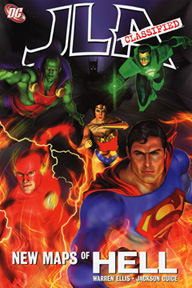 Why read “New Maps of Hell”, Warren Ellis’ take on the JLA?
Why read “New Maps of Hell”, Warren Ellis’ take on the JLA?
Butch Guice, that’s why. The man is aces in each and every effort. Here Guice tackles the icons of the DC Universe and delivers six heroes who seem to live and breathe on the page. Wrinkles, stubble, beauty and brawn… all done with a naturalness that enhances rather than detracts from the fantastical powers and supernatural situations the team gets involved in.
Why this works so well, initially at least, is Ellis gives us wonderful nuggets of Clark, Bruce, Diana, Wally and even Kyle’s everyday lives in the first two chapters. These are distilled and defining moments presenting elements of each character proving that Ellis knows where both the head and heart are when he’s writing, and that he can choose to exploit or ignore them should he wish.
The story is somewhat Lovecraftian, involving the unleashing of a planet-traversing demon, part of J’onn J’onzz’s Martian folklore, who can draw out and exploit the worst fears of the individual. The modern angle is that Luthor, serving as President of the USA was trying to figure out how to harness the beast for military application, but the JLA pre-emptively tackles the beast and their own worst fears to save the planet from descending into madness.
There are some perfect moments for each of the JLA’s heroes here, Ellis providing some sharp dialogue, and occasional exchanges (like J’onn saying “We had a story on my world, which you still call Mars despite my frequently correcting you”) which are exactly what you’d expect from him writing these characters. Guice, not to be outdone, has some exceptionally exciting visual moments (Superman tearing spaceward through the clouds partway through the second chapter, or Guice’s Neal Adams-esque Batman poses) which turn an ultimately disposable story into something fun and worth repeat readings (just ignore the awful cover).
RATING: 
Concrete: Think Like A Mountain
(Dark Horse Books)
By Elgin Carver
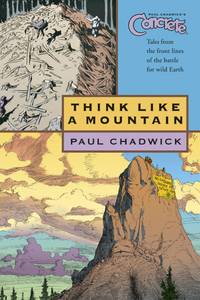 Good propaganda is subtle. It creates in the reader/listener a feeling that they have been presented with sufficient information to come to an informed decision, and that they came to their conclusion through their own thought processes. This is a difficult type of writing, and requires a great deal of skill. To make it entertaining as well puts the successful creation out of the reach of most comic writers. Paul Chadwick, the creator of Concrete, is one of the few who can make the grade.
Good propaganda is subtle. It creates in the reader/listener a feeling that they have been presented with sufficient information to come to an informed decision, and that they came to their conclusion through their own thought processes. This is a difficult type of writing, and requires a great deal of skill. To make it entertaining as well puts the successful creation out of the reach of most comic writers. Paul Chadwick, the creator of Concrete, is one of the few who can make the grade.
Concrete is an alien body, possibly artificial, who is used by creatures not of this world to hold the minds of creatures from worlds they visit for purposes best known to themselves. Leaving in a rush, they abandon this one form with the mind of Ronald Lithgow inside. Made of what seems to be living rock, this body has strength, regeneration, physical, and visual abilities that are far more than human. In order to get the government’s assistance he accepts the persona of Concrete, a federal project to create an android. From these beginnings in the early 1980s, Chadwick has gradually explored the possibilities such a situation would create for Mr. Lithgow, usually with great success. Concrete tried to swim the Atlantic, climbed Everest, has been involved with politics, movie making, and many varied day to day events. The more mundane the events, the better Chadwick is able to explore not just the situation Concrete finds himself in, but the world and society we live in.
Concrete is one of the best and most original of the creator controlled books around. No one should be surprised that the personal politics and philosophy of a person shows through when they are both writer and artist. Acceptance of that fact does not necessarily mean that those thoughts always hold water, no matter how interestingly they are presented.
Many of Chadwick’s stories have a large dose of environmentalism included. Often this is an aside that brings out interesting bits of information and adds color to the story. Here it is the story. Joining a group of environmental extremists, Concrete moves into areas he at first resists as being too extreme, then morphs into a willing participant of illegal activities. Along the way the reader is exposed to what some might confuse as a balanced argument, but which in reality is very one sided.
The artwork remains that same high quality work fans are accustomed to, and the story is entertaining. This series (first published as a six part comic, and includes seven related short stories originally printed in other Dark Horse books) seems to leave Concrete as a radical environmental warrior, this may lead to an interesting future for him, but runs the danger of descending into a dial